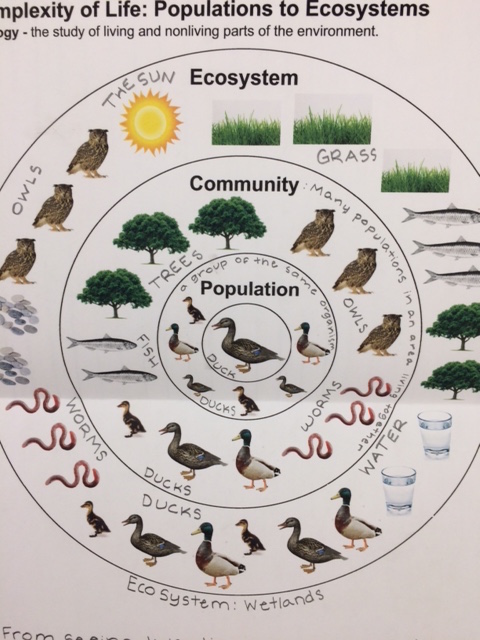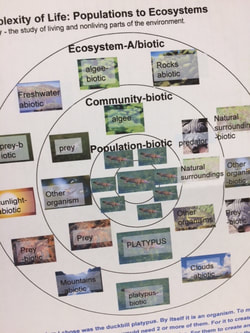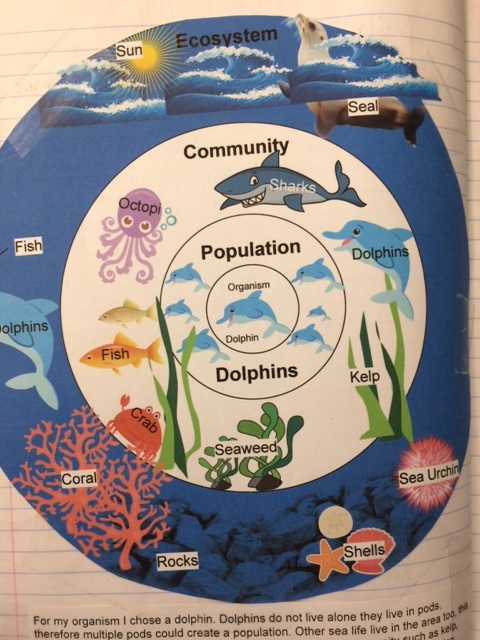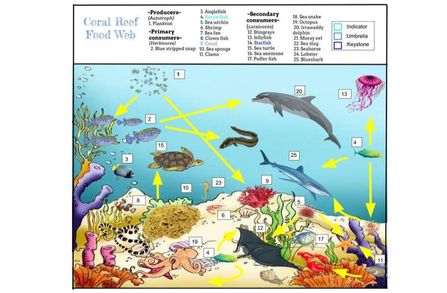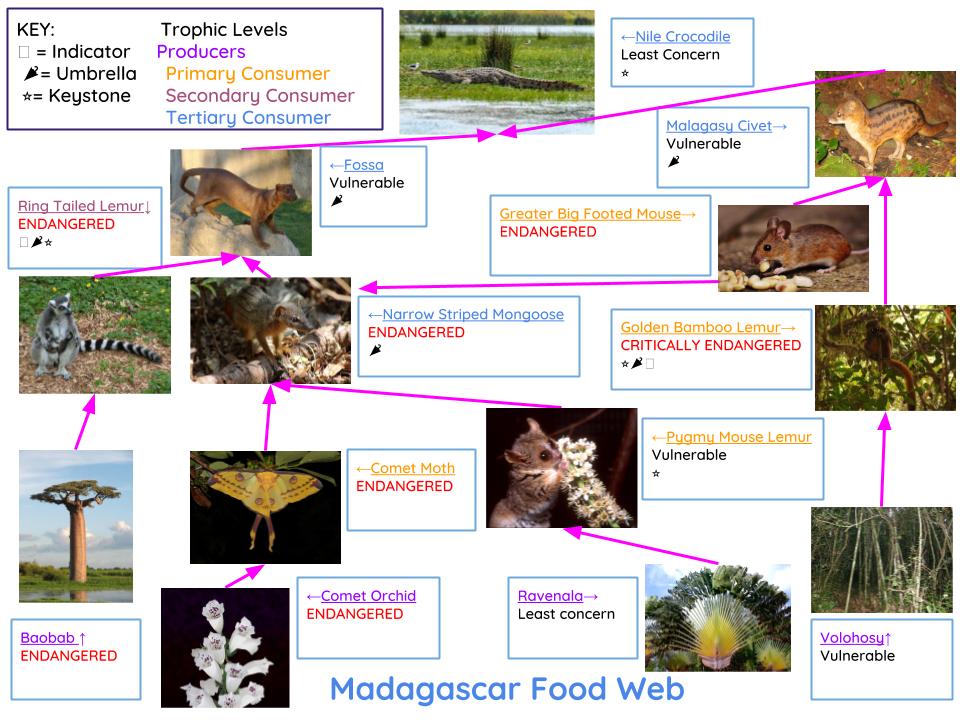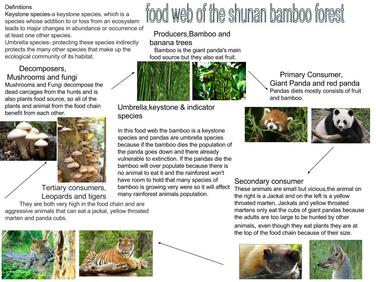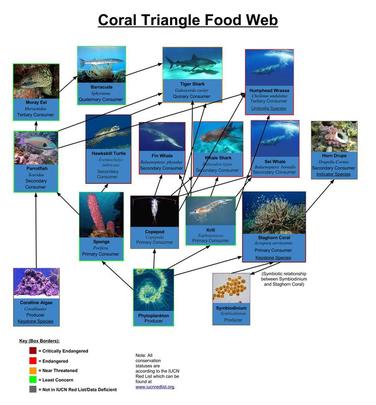|
Table of Contents
ToC Ecosystems 2018-19 Ecosystems ToC 17/18 If you are ABSENT, look at the ToC to see if pages have been added. You are responsible for keeping your notebook up to date. Left-hand pages are ones that are your thinking and these must be your own work. Right-hand pages are group or teacher-directed and can be photocopied using the class photocopier. Big Aha! How can we effectively save endangered species within our communities and on a global scale? Task You are a wildlife biologist and have been asked to write a species recovery plan for an endangered species. Focus Questions
Key Vocabulary English Language Learners are responsible for words with asterisk (*). |
|
|
Structure*
Function* Species* Habitat* Ecosystem* Abiotic* Biotic* Biosphere Communities* Populations* Organisms* Growth rate Predator* Prey* Carnivore* (Primary, secondary, tertiary) Pollutant (Pollution)* Herbivore* |
Omnivore
Competition* Interrelate (interrelation) Symbiosis Mutualism Commensalism Detrivore Ecosystem services Parasitism Food chain* Food pyramid* Food web* Keystone species* Umbrella species Ecologists* Consumers* Producers* |
Threats
Toxins Pollution Invasive Native Carrying capacity Concentrate (concentration) Offspring Bioaccumulation Biomagnification Conservation Conservation status Endangered Threatened Vulnerable Extinct |
Lessons
Lesson 0 - Setup Interactive Science Notebook
Day 1 (Oct. ) - 7.2.0 - 1 Setup Notebook: TOC & Big Aha
Day 2 (Nov. 5 - SUB) - 7.2.1 - 3 Complexity of Life: Organisms to Ecosystems - NEXT YEAR: This is Day 7.
Day 3 (Nov. 7/8) - 7.2.0 - 2 Wolves of Yellowstone & Transition Improv Photosynthesis
Nov. 12 - Unit 1: Summative Modeling Task: Photosynthesis - Zero Waste Challenge due on Thursday
Day 4 (Nov. 13/14) - 2 steps a Month: Month 3 & 5 mass extinctions & 3 gallon challenge RECORDER & REPORTER MAKE ONE COPY of this document. Share the document with your classmates. Your teacher will assign one of the 5 mass extinction events for you to research. Create a poster on a whiteboard or large sheet of paper including key points from your research.
Day 1 (Oct. ) - 7.2.0 - 1 Setup Notebook: TOC & Big Aha
Day 2 (Nov. 5 - SUB) - 7.2.1 - 3 Complexity of Life: Organisms to Ecosystems - NEXT YEAR: This is Day 7.
Day 3 (Nov. 7/8) - 7.2.0 - 2 Wolves of Yellowstone & Transition Improv Photosynthesis
Nov. 12 - Unit 1: Summative Modeling Task: Photosynthesis - Zero Waste Challenge due on Thursday
Day 4 (Nov. 13/14) - 2 steps a Month: Month 3 & 5 mass extinctions & 3 gallon challenge RECORDER & REPORTER MAKE ONE COPY of this document. Share the document with your classmates. Your teacher will assign one of the 5 mass extinction events for you to research. Create a poster on a whiteboard or large sheet of paper including key points from your research.
Lesson 1 - Organisms to Ecosystems
Samples of Concentric Circles
Day 5 (DID EARLIER WITH SUB) - 7.2.1 - 2 Video: Ecosystems -
Day 6 (Nov. 18 & 20/21) - 7.2.1 - 6 Habitats & Niches -
Nov. 19 - Garden time
Day 7 (Nov. 22) - 7.2.1- Threatened and Endangered Species & Habitats and Niches
Day 8 (Dec. 2 & 3 ) - Revisit forms & Collect data on carbon sequestration & discuss findings
Day 9 (Dec.4/5 ) - 7.2.1 IUCN Red List & Biomes & Review Carbon Sequestration form
Day 10 (Dec. 6) - 7.2.1 - Reviewed Government Report Resource Availability
Dec. 11 - Time to give comments on government report
Day 11 (Dec. 12/13) 7.2.1 - Rabbits & Foxes
Lesson 2 Predator, Competitive & Mutually Beneficial Relationships
SUB Day 12 (Dec. 9 ) 7.2.1 - Types of Relationships (Reading) & CER
SUB Day 24 (Dec. 16) - Read 6th Mass Extinction
Dec. 17 - Garden
Day 13 (Dec. 18/19) - 7.2.2 Cougar Hunt & Carrying Capacity
Day 14 (Dec. 19/20) - 7.2.2 Cougar Hunt Graphs
Day 15 (Jan. 6) -- 7.2.3 Human Population & Keystone, Umbrella, and Indicator Species & 2 Steps a Month: Month 4
Day 16 (Jan. 7) - 7.2.3 Introduce Food Web & Field Trip Forms
Day 17 (Jan. 8/9) - Work day on Food Web - Look on Canvas
Day 6 (Nov. 18 & 20/21) - 7.2.1 - 6 Habitats & Niches -
Nov. 19 - Garden time
Day 7 (Nov. 22) - 7.2.1- Threatened and Endangered Species & Habitats and Niches
Day 8 (Dec. 2 & 3 ) - Revisit forms & Collect data on carbon sequestration & discuss findings
Day 9 (Dec.4/5 ) - 7.2.1 IUCN Red List & Biomes & Review Carbon Sequestration form
Day 10 (Dec. 6) - 7.2.1 - Reviewed Government Report Resource Availability
Dec. 11 - Time to give comments on government report
Day 11 (Dec. 12/13) 7.2.1 - Rabbits & Foxes
Lesson 2 Predator, Competitive & Mutually Beneficial Relationships
SUB Day 12 (Dec. 9 ) 7.2.1 - Types of Relationships (Reading) & CER
SUB Day 24 (Dec. 16) - Read 6th Mass Extinction
Dec. 17 - Garden
Day 13 (Dec. 18/19) - 7.2.2 Cougar Hunt & Carrying Capacity
Day 14 (Dec. 19/20) - 7.2.2 Cougar Hunt Graphs
Day 15 (Jan. 6) -- 7.2.3 Human Population & Keystone, Umbrella, and Indicator Species & 2 Steps a Month: Month 4
Day 16 (Jan. 7) - 7.2.3 Introduce Food Web & Field Trip Forms
Day 17 (Jan. 8/9) - Work day on Food Web - Look on Canvas
Samples of Food Web
Day 19 (Jan. 9/10) - Reading: Owl Pellet Dissection & work on Food Web :
Day 20 (Jan. 13) - Owl Pellet Dissection & CER & Collect Gallon Challenge
Day 21 (Jan. 14) - Finish Owl Pellet CER conversation & 20 min. garden time & Collect 3-Gallon Challenge
Lesson 3: Threats to Biodiversity
Day 22 (Jan. 15/16) - Asian Silver Carp CER on Canvas - This is an open notebook quiz.
Day 23 (Jan. - SUB ) - Reading on the 6th Mass Extinction
Day 24 (Jan. 16) - Field trip to Racing Extinction (Jan. 17 - Sub P7)- Reflection on Racing Extinction and End of Unit CER
Day 25 (Jan. 21) - 7.3.3 Species Recovery Plan Introduction - NEXT YEAR move under summative task
Day 26 (Jan. 22) - 7.3.3 Albatross bolus dissection & CER; Done early? (Virtual Albatross dissection)
Lesson 4: Summative Task
Day 27 (Jan. 23/24) - Species Recovery Plan Work Day
Day 28 (Jan. 27) - Albatross Bolus CER written
Day 29 (Jan. 28) - spent 15 minutes on organizing ISN & did method 1 of Biologist on Safari - Wild dogs & White Rhinos
Day 30 (Jan. 29/30 ) - Finish Biologists on Safari CER
Day 31 (Jan. 30/31) - Work on Species Recovery Project / End of Unit CER / BIg Aha!
Day 32 (Feb. 3) - introduce video contest ideas and newsletter
Day 33 (Feb. 4) - Collect ISN Work on Endangered Species Recovery Plan - Submit Newsletter piece to editor and work on VIDEO checklist of how far people are, discuss maps, threats, & brainstorm ideas a kid can do to make a difference - 7 Billion video contest; Coastal California video contest
Feb. 5 Global School Play Day /Feb. 6 work day on Species project
Feb. 7 - work on videos - Fill in Work Plan - Keep record of your plans
Feb. 8 - work on videos - Fill in Work Plan - Keep record of yourplans
Feb. 10 Start new unit ...
Feb. 12 Work Day on Endangered Species slide show and videos - LAST WORK DAY - Fill in Work Plan
Feb. 13/Feb. 14 - Presentations and Video OR Alfred Wegner CER - if you have a partner for the video, work on the video as you will NOT get any more in class time. Presentations for videos will start on Monday, March 2nd
Palm Oil
THIS IS FROM 2017-2018 - Don't do these things yet...
Day 23? Maybe add in Asian Silver population measure
Day 11 (Nov. 28/29) - 7.2.2 - Threatened Habitat Research RECORDER & REPORTER: Threatened Habitat Research (MAKE A COPY, SHARE WITH GROUP & TEACHER)
Day 12 (Nov. 29/30) - 7.2.2 Threatened Habitat Research & Slideshow. Here is the Checklist of Requirements.
Day 13 (Dec. 1) - 7.2.2 Slideshow check-in & on Google Classroom get this document, INDIVIDUAL Species report
- short period - assembly) - 7.2.3 Habitat Slideshow
2016-2017 - Stuff we didn't do in 2017-18 or embedded above
Stronger Clearer: Why should we care about biodiversity?
Flashcards on Quizlet (posted on Google Classroom)
Day 25 (Jan. 24) - Modeling Sampling - Invasive Species
6th Mass Extinction
Day 35 (Feb. 14) - Coral Lab - Put in Chemistry Unit
Day 36 (BLOCK - Feb. 15/16) - Action Plan - MAKE A COPY and put in group folder
Day 20 (Jan. 13) - Owl Pellet Dissection & CER & Collect Gallon Challenge
Day 21 (Jan. 14) - Finish Owl Pellet CER conversation & 20 min. garden time & Collect 3-Gallon Challenge
Lesson 3: Threats to Biodiversity
Day 22 (Jan. 15/16) - Asian Silver Carp CER on Canvas - This is an open notebook quiz.
Day 23 (Jan. - SUB ) - Reading on the 6th Mass Extinction
Day 24 (Jan. 16) - Field trip to Racing Extinction (Jan. 17 - Sub P7)- Reflection on Racing Extinction and End of Unit CER
Day 25 (Jan. 21) - 7.3.3 Species Recovery Plan Introduction - NEXT YEAR move under summative task
Day 26 (Jan. 22) - 7.3.3 Albatross bolus dissection & CER; Done early? (Virtual Albatross dissection)
Lesson 4: Summative Task
Day 27 (Jan. 23/24) - Species Recovery Plan Work Day
Day 28 (Jan. 27) - Albatross Bolus CER written
Day 29 (Jan. 28) - spent 15 minutes on organizing ISN & did method 1 of Biologist on Safari - Wild dogs & White Rhinos
Day 30 (Jan. 29/30 ) - Finish Biologists on Safari CER
Day 31 (Jan. 30/31) - Work on Species Recovery Project / End of Unit CER / BIg Aha!
Day 32 (Feb. 3) - introduce video contest ideas and newsletter
Day 33 (Feb. 4) - Collect ISN Work on Endangered Species Recovery Plan - Submit Newsletter piece to editor and work on VIDEO checklist of how far people are, discuss maps, threats, & brainstorm ideas a kid can do to make a difference - 7 Billion video contest; Coastal California video contest
Feb. 5 Global School Play Day /Feb. 6 work day on Species project
Feb. 7 - work on videos - Fill in Work Plan - Keep record of your plans
Feb. 8 - work on videos - Fill in Work Plan - Keep record of yourplans
Feb. 10 Start new unit ...
Feb. 12 Work Day on Endangered Species slide show and videos - LAST WORK DAY - Fill in Work Plan
Feb. 13/Feb. 14 - Presentations and Video OR Alfred Wegner CER - if you have a partner for the video, work on the video as you will NOT get any more in class time. Presentations for videos will start on Monday, March 2nd
Palm Oil
THIS IS FROM 2017-2018 - Don't do these things yet...
Day 23? Maybe add in Asian Silver population measure
Day 11 (Nov. 28/29) - 7.2.2 - Threatened Habitat Research RECORDER & REPORTER: Threatened Habitat Research (MAKE A COPY, SHARE WITH GROUP & TEACHER)
Day 12 (Nov. 29/30) - 7.2.2 Threatened Habitat Research & Slideshow. Here is the Checklist of Requirements.
Day 13 (Dec. 1) - 7.2.2 Slideshow check-in & on Google Classroom get this document, INDIVIDUAL Species report
- short period - assembly) - 7.2.3 Habitat Slideshow
2016-2017 - Stuff we didn't do in 2017-18 or embedded above
Stronger Clearer: Why should we care about biodiversity?
Flashcards on Quizlet (posted on Google Classroom)
Day 25 (Jan. 24) - Modeling Sampling - Invasive Species
6th Mass Extinction
Day 35 (Feb. 14) - Coral Lab - Put in Chemistry Unit
Day 36 (BLOCK - Feb. 15/16) - Action Plan - MAKE A COPY and put in group folder
Future things
American Museum of Natural History - biodiversity connections
Small Water Cycle & Blue Carbon (23 min) - sea grass, mangroves. and salt marshes because of long term sequestration and storage (not kelp forest because of not long term storage - however super valuable) = double sequester than tropical or temperate rainforest; Loss of coastal wetlands each year is the equivalent to the carbon emissions Great Britain; Eating a shrimp cocktail is the equivalent of eating an entire cow based on the agriculture impact of coastal wetlands that can store 10,000 years of carbon emissions
NEXT YEAR: Look at LCD Resources for CO2 and plants
Add in: Day 6 - Plastics in the Water Column (Monterey Bay Aquarium activity)
Day 7 - Plastics in the Water Column continued - Introduce Claim-Evidence-Reason Graphic Organizer. and t's Okay to Be Smart: How Much Plastic is in the Ocean? video
American Museum of Natural History - biodiversity connections
Small Water Cycle & Blue Carbon (23 min) - sea grass, mangroves. and salt marshes because of long term sequestration and storage (not kelp forest because of not long term storage - however super valuable) = double sequester than tropical or temperate rainforest; Loss of coastal wetlands each year is the equivalent to the carbon emissions Great Britain; Eating a shrimp cocktail is the equivalent of eating an entire cow based on the agriculture impact of coastal wetlands that can store 10,000 years of carbon emissions
NEXT YEAR: Look at LCD Resources for CO2 and plants
Add in: Day 6 - Plastics in the Water Column (Monterey Bay Aquarium activity)
Day 7 - Plastics in the Water Column continued - Introduce Claim-Evidence-Reason Graphic Organizer. and t's Okay to Be Smart: How Much Plastic is in the Ocean? video

